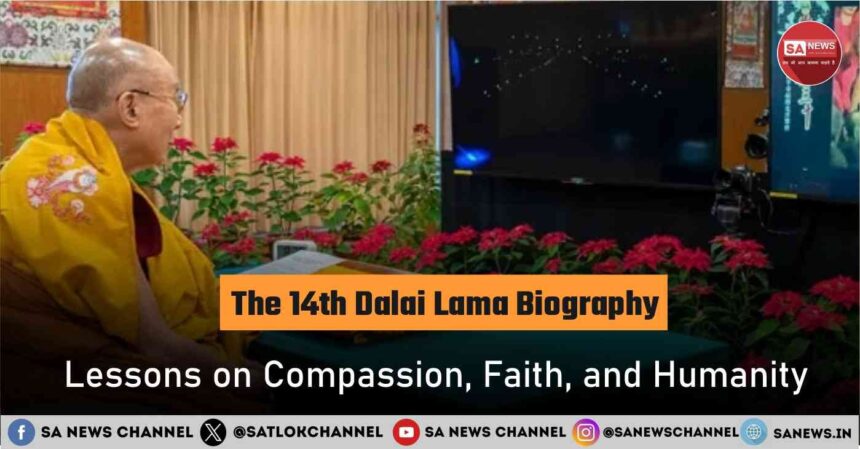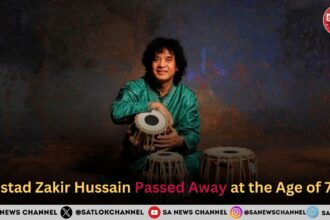The life of His Holiness the 14th Dalai Lama, Tenzin Gyatso, is one of irrevocable peace, spiritual expertise, and empathy. From his identification as a divine rebirth to exile from Tibet and his teachings throughout the globe, his biography is a testament to a life dedicated to humanity’s higher consciousness.
- The Birth and Identification of the Early Dawn
- From Lhamo Thondup to Tenzin Gyatso
- The Path of Spiritual Enlightenment
- Rising Amidst Crisis
- The Start of a New Beginning and Exile
- Teachings That Transcend Religions
- A Voice of Global Harmony
- The Author and Thinker
- Blending Science and Spirituality
- Humanitarian Vision
- Why Enlightenment Without True Worship Cannot End Rebirth
- FAQs on Biography of Dalai Lama
- The 14th Dalai Lama: Tenzin Gyatso
- Born on July 6, 1935, in Taktser, Tibet
- At the age of two, he was recognized as the reincarnation of the 13th Dalai Lama
- 1959 into exile
- Nobel Peace Prize winner, 1989
- Champion of the world in unifying, world peace, and spiritual awakening
The Birth and Identification of the Early Dawn
In 1935, in the peaceful surroundings of Taktser, Tibet, a baby called Lhamo Thondup was born to poor farmers. Unknown to them, fate had already selected this child to carry the symbol of Tibet’s spiritual leadership. Through divine visions and signs, monks learned that he was the rebirth of the 13th Dalai Lama – a spiritual icon reborn.
From Lhamo Thondup to Tenzin Gyatso
At two years old, he was recognized officially as the 14th Dalai Lama and given the name Tenzin Gyatso, which translates to “Ocean of Wisdom.” His transformation from a regular child into a venerated monk was a beacon of Tibet’s spiritual heritage.
The Path of Spiritual Enlightenment
As he matured, Tenzin Gyatso studied advanced Buddhism – philosophy, logic, meditation, and ethics. His mentors shaped him not only as a scholar but as a kind-hearted leader who could lead people to peace within. His peaceful wisdom personified him as love and strength.
Rising Amidst Crisis
At fifteen, he became the supreme ruler of Tibet when China invaded in 1950. Under the unthinkable pressure, the teenage Dalai Lama stood for peace rather than war, opting for words instead of bullets – a move that testifies to his profound moral richness.
The Start of a New Beginning and Exile
In 1959, the Dalai Lama escaped from Tibet after a bloody rebellion. Traveling through the Himalayas, he took refuge in India. He came to rest at Dharamshala, where he created the Tibetan government-in-exile – keeping his people’s religion, language, and culture alive. Exiled, he started anew as a world ambassador of peace.
Teachings That Transcend Religions
The Dalai Lama’s words echo far beyond Buddhism. He is teaching that kindness and compassion are universal virtues that are essential to every human soul. His message is simple but profound – the world can only heal when hearts are open and minds are gentle.
A Voice of Global Harmony
His peaceful smile and sage words have touched millions of people from nations and religions. The Dalai Lama was awarded the Nobel Peace Prize in 1989 for his peaceful resistance for freedom and his principle of respect for others.
The Author and Thinker
His books, like The Art of Happiness and Freedom in Exile, join ancient wisdom with contemporary thinking. They show us how to seek balance in the midst of turmoil and peace amidst storminess – a universal gift for each generation.
Blending Science and Spirituality
The Dalai Lama bridges religion and science. He invites scientists to dialogue, trusting that they can collectively open the secrets of consciousness and cultivate compassion through knowledge.
Humanitarian Vision
Aside from temples and doctrines, he is also a humanitarian – advocating for education, equality, and moral living. Leaders, intellectuals, and common people alike remain inspired by his campaign for ethics based on compassion.
His Words :
- Be kind whenever possible. It is always possible.
- My religion is kindness.
- Happiness is not something ready-made; it comes from your own actions.
Why Enlightenment Without True Worship Cannot End Rebirth
The life of the 14th Dalai Lama is indeed an inspiring example of compassion, peace, and human kindness. Yet, as Saint Rampal Ji Maharaj explains in His scripture- based discourses, even great saints and monks who dedicate their lives to peace cannot attain true salvation without following the path of true worship (Sat-Bhakti) of the Supreme God Kabir Ji. The Dalai Lama, despite his noble deeds and spiritual influence, did not receive the eternal knowledge of God Kabir Ji, who alone can liberate souls from the cycle of birth and death.
According to the holy scriptures of all religions, salvation is achieved only through devotion to the Almighty Kabir Ji under the guidance of a Tatvdarshi Saint. Sant Rampal Ji Maharaj is revealing this true path today, enabling souls to achieve that everlasting peace which even great leaders have long sought but could not attain.
FAQs on Biography of Dalai Lama
Q2. Why did the Dalai Lama leave Tibet?
Since China occupied Tibet in 1959, he went into exile and has been a refugee in India to ensure peacefulness.
Q3. What is the core teaching of the Dalai Lama?
His main teaching is based on compassion, kindness, non-violence, and striving for inner happiness.
Q4. What are some of the Dalai Lama’s well-known books?
His popular books are The Art of Happiness, Freedom in Exile, and The Universe in a Single Atom.
Q5. What does Saint Rampal Ji Maharaj think about the Dalai Lama?
Saint Rampal Ji Maharaj appreciates the peaceful means of the Dalai Lama but preaches that salvation can be achieved only with the worship of Supreme God Kabir as instructed in the scriptures.









